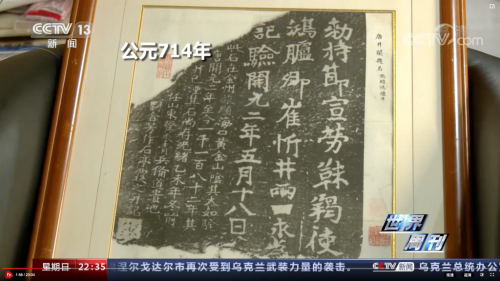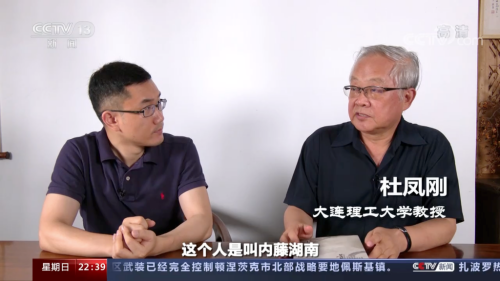CCTVInterview withProfessor Du Fenggang forHis Contribution to the Return of “Honglujing Stele of Tang Dynasty”
August 16, 2022
Japan officially announced its unconditional surrender on August 15th1945, 77 years ago. Today, there is another historical juncture. Recently, the CCTV (China Central Television) News Channel presented a special reportPlundered National Treasures on its program “World Weekly”, focusing on the historical artifacts plundered by Japan during the Russo-Japanese War (1904-1905). Namely, “Honglujing Stele of Tang Dynasty (618 A.D.-907 A.D.)” and the Stele guardian “Pavilion of Stele in Tang Dynasty”. During the special report, an exclusive interview was conducted with professor Du Fenggang, a teacher from Dalian University of Technology (DUT), amongst other scholars.

“Honglujing Stele of Tang Dynasty” and “Pavilion of Stele in Tang Dynasty” are of particular important historical value among the artifacts that Japan plundered from China, as they recorded the reunification process of ancient China, making them of great significance for researching Chinese history. After the Russo-Japanese War at the outset of the 20th century, “Honglujing Stele of Tang Dynasty” was pillaged to Japan by the Japanese Navy for its important historical and academic value. As a so-called “trophy” for Japanese Emperor Meiji in Russo-Japanese war, “Honglujing Stele of Tang Dynasty” is still stored in the Japanese Imperial Palace to this day. Far from its homeland China, it has thus been difficult for Chinese people to see it for over a hundred years.

Professor Du Fenggang has been committed to textual research and the interpretation of the Stele inscription, with his unremitting efforts to the return of the “Honglujing Stele of Tang Dynasty”. As professor Du Fenggang noted in the interview: “The Stele represents the Tang Dynasty’s claim of its sovereignty for Northeastern China in 714 A.D. Nonetheless, Japan’s plunder of the Stele and Pavilion through war to their nation manifests their coveted ambition for the Northeast of China, at least since that time.”
On April 15th, 2022, the Japanese civil organization “The Association for the Return of Chinese Artifacts”, founded by a famous Japanese lawyer Kiyoshi Ichinose(一濑敬一郎), held a press conference, urging the Japanese government to voluntarily return Chinese artifacts plundered during the First Sino-Japanese War (1894-1895), Russo-Japanese War and Japanese War of Aggression against China (1931-1945). “Honglujing Stele of Tang Dynasty” is among the first four artifacts they demanded were returned. It was also emphasized by professor Du Fenggang: “Despite the fact that the Stele was plundered by Japan unfortunately in wartime, we still hope it would become a symbol of the friendship between China and Japan when it is returned on a voluntary basis.”
DUT has always concentrated on academic research and the return of “Honglujing Stele of Tang Dynasty”. In August 2005, the First China-Japan Symposium on Honglujing Stele of Tang Dynasty was held at DUT; In April 2004, a ceremony was organized at DUT for the book launch ofHonglujing Stele of Tang Dynasty published by People’s Publishing House, with DUT’s engagement in the compilation process. After the death of Luo Zhewen, an eminent expert in literature and history and the chairman of Association for Studies of Honglujing Stele of Tang Dynasty, the position was taken by professor Lin Anxi from DUT, who would be responsible for subsequent tasks on the study of the Stele and its return.
